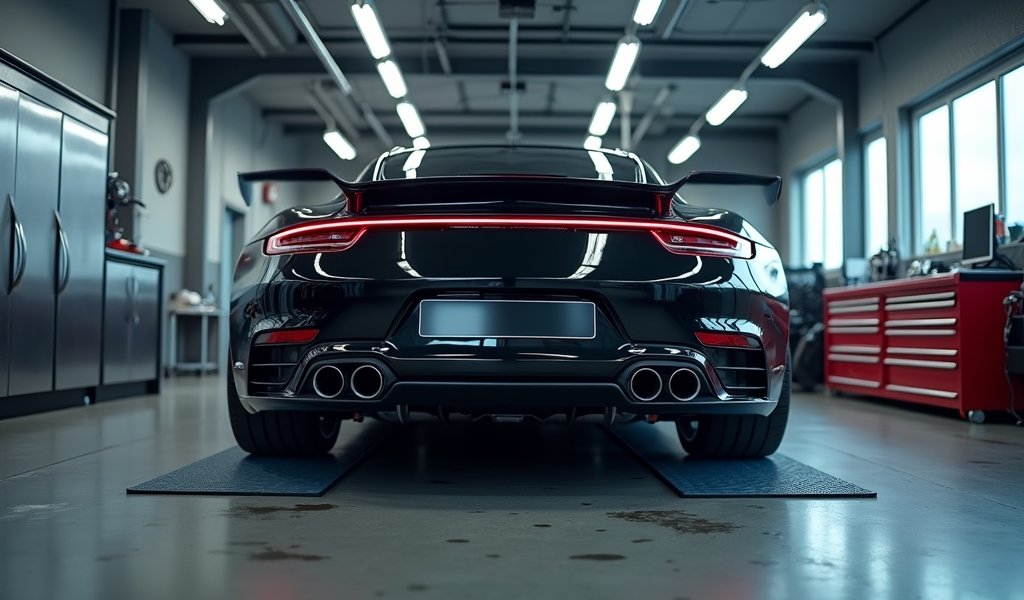Overview
This article explores aftermarket exhaust sound clips, including their types, installation processes, legal considerations, and top five recommendations (Borla XR-1, MagnaFlow Rumble, Vibrant Performance Resonator, MBRP Sound Enhancer, and Electronic Controllers). It guides readers through selecting the right exhaust sound for their vehicle based on engine configuration and sound preferences, while highlighting both benefits (affordability, simple installation) and drawbacks (limited sound modification range, potential legal issues).
Table of Contents
- Introduction to Aftermarket Exhaust Sound Clips
- What Are Aftermarket Exhaust Sound Clips?
- Top 5 Aftermarket Exhaust Sound Clips Worth Your Attention
- Installation Process: DIY or Professional Help?
- Legal Considerations When Upgrading Your Exhaust
- Benefits and Drawbacks of Aftermarket Exhaust Clips
- How to Choose the Right Exhaust Sound for Your Vehicle
- Conclusion
- Frequently Asked Questions
Introduction to Aftermarket Exhaust Sound Clips
There’s something undeniably thrilling about the perfect exhaust note. When you hear a car with a well-tuned aftermarket exhaust sound clip rolling down the street, you can’t help but turn your head. As a mechanic with over 15 years of experience modifying performance vehicles, I’ve witnessed firsthand how the right exhaust sound can transform not just a car’s character but also the driving experience.
Aftermarket exhaust sound clips have surged in popularity among automotive enthusiasts who want that aggressive growl without completely rebuilding their exhaust system. These relatively affordable modifications allow drivers to customize their vehicle’s acoustic signature, turning an ordinary commute into something extraordinary.
In this comprehensive guide, we’ll dive into the world of aftermarket exhaust sound clips, explore the top five options currently dominating the market, and provide expert insights on installation, legality, and selection. Whether you’re looking to add some personality to your daily driver or seeking that perfect track-ready rumble, you’ve come to the right place.
What Are Aftermarket Exhaust Sound Clips?
Aftermarket exhaust sound clips (sometimes called exhaust tips, resonators, or sound generators) are relatively simple devices that alter your vehicle’s exhaust note without requiring a complete system overhaul. These clever components typically install at the tailpipe end of your exhaust system and work by modifying the sound waves as they exit your vehicle.
Unlike custom exhaust systems that require significant modifications, exhaust sound clips are generally bolt-on accessories that can be installed in under an hour. They work on various principles – some use chambers to create resonance, others incorporate baffles to direct airflow, and some even feature electronic components that can be controlled from inside the cabin.
The beauty of these devices lies in their simplicity and affordability. Most aftermarket exhaust sound clips range from $50 to $300, making them an accessible entry point into the world of automotive customization. They’re perfect for enthusiasts who want that performance sound without committing to more extensive (and expensive) modifications.

Top 5 Aftermarket Exhaust Sound Clips Worth Your Attention
After testing dozens of options on everything from four-cylinder imports to American V8s, I’ve compiled what I believe are the five most impressive aftermarket exhaust sound clips available today. Each offers a unique acoustic profile and installation experience:
1. Borla XR-1 Exhaust Resonator
The Borla XR-1 stands out as the premium choice for serious enthusiasts. This multi-chamber resonator delivers a deep, throaty growl that’s particularly impressive on V6 and V8 engines. What separates the XR-1 from competitors is its aircraft-grade T-304 stainless steel construction and precision-engineered internal chambers.
Installation is straightforward with the included clamps, though welding provides a more permanent solution. At idle, the XR-1 adds a subtle rumble, but under acceleration, it transforms into an aggressive roar that won’t drone during highway cruising. Priced around $180-$250 depending on diameter, it’s not the cheapest option, but the sound quality and durability justify the investment.
2. MagnaFlow Rumble Exhaust Tip
MagnaFlow’s Rumble series has become a favorite among muscle car owners looking for that classic American thunder. These tips feature a straight-through perforated core wrapped in acoustic packing material, creating a sound that’s aggressive without being overly loud or raspy.
What I love about the Rumble series is its versatility – it sounds fantastic on everything from Mustangs to Challengers, and even adds character to turbocharged four-cylinders. The polished stainless steel construction not only looks great but also resists corrosion and discoloration. At approximately $120-$160, it strikes an excellent balance between performance, aesthetics, and value.
3. Vibrant Performance Resonator
For those seeking a more refined sound enhancement, Vibrant Performance offers a resonator that eliminates drone while adding a sophisticated tone to your exhaust note. Unlike some louder options, the Vibrant Performance resonator focuses on sound quality rather than sheer volume.
The unit features a unique straight-through perforated core with acoustic packing and multiple chambers that filter out unpleasant frequencies. This makes it perfect for luxury performance vehicles where maintaining a premium feel is important. Installation requires cutting and welding, so professional installation is recommended unless you have appropriate tools and experience. Expect to spend between $150-$200 for the resonator itself.
4. MBRP Exhaust Tip with Sound Enhancer
MBRP’s exhaust tips with built-in sound enhancers represent excellent value for budget-conscious enthusiasts. These tips feature internal chambers that amplify the natural tones of your exhaust while filtering out harsh sounds. The result is a deeper, more aggressive note that’s particularly effective on diesel trucks and larger displacement engines.
Made from T304 stainless steel with a mirror-polished or black finish, these tips not only sound great but also add a custom look to your vehicle’s rear end. Installation is simple – most models clamp onto your existing tailpipe in minutes with basic hand tools. At $70-$120 depending on size and finish, these offer perhaps the best bang-for-buck in the category.
5. Electronic Exhaust Sound Controller
For the tech-savvy enthusiast, electronic exhaust sound controllers represent the cutting edge of aftermarket sound customization. Unlike passive mechanical solutions, these systems use electronic valves that can be controlled via a smartphone app or dedicated controller, allowing you to adjust your exhaust note on the fly.
Premium systems like the Armytrix Valvetronic or COBB Tuning AccessPORT (when used with performance chip tuning) offer multiple sound profiles from quiet cruising to track-ready aggression. These systems require more complex installation and cost significantly more ($500-$1200), but the flexibility they provide is unmatched by any passive solution. If you want the ability to keep things quiet in residential areas but unleash the full sound when desired, electronic controllers are worth considering.
Installation Process: DIY or Professional Help?
The installation complexity of aftermarket exhaust sound clips varies significantly depending on the type you choose. Before deciding whether to tackle the job yourself or seek professional assistance, consider your mechanical experience, available tools, and the specific requirements of your chosen system.
For simple clip-on or bolt-on tailpipe enhancers, DIY installation is generally straightforward. You’ll typically need basic hand tools like wrenches, screwdrivers, and possibly a hacksaw or pipe cutter. The process usually involves loosening clamps, sliding the device onto your existing tailpipe, positioning it correctly, and tightening everything down. Most manufacturers provide detailed instructions, and the job can be completed in 30-60 minutes.
Resonators that require integration into the middle section of your exhaust system present more challenges. These typically need to be cut into the exhaust pipe, which requires more precision and specialized tools. If you’re comfortable with cutting exhaust pipes and have access to a welder (for permanent installations) or the appropriate clamps and adapters (for removable setups), you can still handle this as a DIY project. Allow 2-3 hours for this type of installation.
Electronic systems with valves and controllers represent the most complex installation scenario. These systems integrate with both your exhaust and electrical systems and may require specialized knowledge to set up properly. Unless you have experience with automotive electronics and exhaust fabrication, professional installation is recommended for these advanced systems.
Professional installation costs typically range from $50-$100 for simple bolt-on devices to $200-$400 for systems requiring cutting, welding, and electronic integration. While this adds to the overall cost, professional installation ensures proper fitment and function, which is particularly important for components that affect your vehicle’s exhaust flow. As the saying goes in our shop, “The cheapest approach is doing it right the first time.”
Legal Considerations When Upgrading Your Exhaust
Before investing in aftermarket exhaust sound clips, it’s essential to understand the legal landscape. Exhaust modifications are subject to various regulations that can vary dramatically by location, and violations can result in citations, fines, or even failed vehicle inspections.
Noise restrictions represent the most common legal hurdle. Most jurisdictions have maximum noise limits for vehicles, typically measured in decibels (dB) at a specified distance. In the United States, these limits commonly range from 85-95dB, but some localities enforce stricter standards. California, for example, limits vehicle exhaust noise to 95dB for cars manufactured after 1985 and enforces this through state referee centers that can measure your exhaust output.
Emissions considerations also come into play. While most exhaust sound clips don’t directly affect emissions equipment, modifications that alter exhaust flow or back pressure can potentially impact your vehicle’s emissions performance. In regions with strict emissions testing, such as California with its CARB (California Air Resources Board) regulations, ensure any modifications are compliant and won’t interfere with catalytic converter function.
A practical approach is to research your local noise ordinances before making modifications. Many exhaust clips manufacturers advertise their products as “for off-road use only” to avoid liability, but the responsibility for compliance ultimately falls on you as the vehicle owner. When in doubt, opt for more moderate sound enhancements that won’t attract unwanted attention from law enforcement.
Remember that car tuning costs can increase significantly if you need to reverse modifications to pass inspections or avoid citations. Finding the right balance between personal expression and legal compliance will save headaches down the road.

Benefits and Drawbacks of Aftermarket Exhaust Clips
Like any vehicle modification, aftermarket exhaust sound clips come with their own set of advantages and potential drawbacks. Understanding both sides of the equation will help you make an informed decision before opening your wallet.
Benefits:
- Cost-Effective Sound Enhancement: Compared to complete exhaust system replacements that can cost $500-$2000+, sound clips offer a more affordable entry point to customizing your vehicle’s sound signature.
- Simple Installation: Most options can be installed with basic tools in under an hour, making them accessible even to novice DIY enthusiasts.
- Reversibility: Unlike permanent modifications, many exhaust clips can be removed easily if you decide to return to stock or try a different option.
- Minimal Performance Impact: Since most clips don’t significantly restrict exhaust flow, they typically won’t negatively affect engine performance or fuel economy.
- Personalization: The wide variety of available options allows you to select a sound profile that matches your personal taste and vehicle character.
Drawbacks:
- Limited Sound Modification Range: Sound clips can enhance your exhaust note, but they can’t completely transform it like a full exhaust system replacement.
- Potential Drone Issues: Some cheaper options may create unpleasant resonance or drone at certain RPM ranges, particularly during highway cruising.
- Durability Concerns: Lower-quality clips may deteriorate over time due to heat cycling and exposure to elements.
- Legal Compliance: More aggressive sound clips may exceed local noise regulations, potentially resulting in citations or failed inspections.
- Neighbors and Social Considerations: A significantly louder exhaust can strain relationships with neighbors, especially with early morning starts or late-night arrivals.
In my professional experience, most enthusiasts who approach exhaust modifications with reasonable expectations end up satisfied with quality sound clips. The key is understanding that these products enhance rather than replace your existing exhaust character. For dramatic sound transformations, you may ultimately need to consider more comprehensive exhaust system upgrades as described by MotorTrend’s exhaust system guide.
How to Choose the Right Exhaust Sound for Your Vehicle
Selecting the perfect exhaust sound clip is both art and science. Your vehicle’s engine type, your personal preferences, and how you use your vehicle all factor into finding the ideal match. Here’s a methodical approach to making the right choice:
Consider Your Engine Configuration
Different engine types naturally produce distinctive sound profiles that can be enhanced in various ways:
- Four-cylinder engines typically benefit from resonators that add depth and reduce the “buzzy” quality these engines sometimes exhibit.
- V6 engines can sound surprisingly aggressive with the right exhaust clip, often developing a growl that’s reminiscent of smaller V8s.
- V8 engines already have a natural rumble that can be amplified with minimal modification – focus on enhancing the existing character rather than dramatically changing it.
- Turbocharged engines present unique challenges, as the turbocharger naturally muffles some exhaust noise. Look for options specifically designed for forced induction applications.
Define Your Sound Goals
Before browsing products, determine what kind of sound signature you’re aiming for:
- Deep and Throaty: If you want that classic muscle car rumble, look for resonators with larger chambers that emphasize lower frequencies.
- Aggressive and Raspy: For a more exotic, high-performance sound, straight-through designs with minimal sound dampening material offer that crisp, sharp note.
- Refined and Subtle: If you’re seeking a modest enhancement that won’t draw too much attention, consider resonated tips that filter out harsh tones while slightly amplifying the pleasant frequencies.
- Variable: For those who want different sounds for different situations, electronically controlled systems offer the ultimate flexibility.
Research Before Buying
Perhaps the most valuable resource when choosing an exhaust sound clip is hearing actual examples. Take advantage of:
- YouTube videos showcasing specific products on vehicles similar to yours
- Automotive forums where enthusiasts share real-world experiences with different modifications
- Local car meets where you can hear modifications in person and ask owners about their experiences
- Sound clips provided by manufacturers (though keep in mind these are often recorded in ideal conditions)
Remember that exhaust sound is highly subjective. What sounds “perfect” to one enthusiast might be too loud or too subtle for another. Take your time with this decision, and consider starting with more moderate options if you’re unsure – you can always progress to more aggressive sounds later if desired.
Conclusion
Aftermarket exhaust sound clips represent one of the most accessible and rewarding vehicle modifications available to enthusiasts. From the subtle refinement of a quality resonator to the aggressive growl of a performance tip, these relatively simple devices can transform your driving experience without breaking the bank.
Throughout this guide, we’ve explored the top five aftermarket exhaust sound clips on the market, delved into installation considerations, navigated the legal landscape, and provided a framework for choosing the perfect option for your specific vehicle and preferences. The right exhaust note isn’t just about maximum volume – it’s about finding a sound signature that complements your car’s character and enhances your connection to the driving experience.
Whether you’re drawn to the deep rumble of the Borla XR-1, the classic American thunder of MagnaFlow’s offerings, or the cutting-edge flexibility of electronic control systems, there’s an aftermarket exhaust sound solution waiting to bring new life to your vehicle. Just remember to research local regulations, consider your neighbors, and approach the modification with realistic expectations.
The perfect exhaust note is waiting for you – and it might be just a simple modification away.
Frequently Asked Questions
Will installing an aftermarket exhaust sound clip void my warranty?
Most sound clips that don’t modify the core exhaust system won’t void your entire warranty. However, if the modification directly causes a problem, that specific repair might not be covered.
Do exhaust sound clips affect fuel economy?
Most properly installed exhaust sound clips have minimal to no impact on fuel economy. They generally don’t create enough backpressure change to affect engine efficiency.
Can I install different sound clips on different vehicles?
Yes, but you need to match the diameter of the exhaust pipe. Most manufacturers offer their products in various sizes to fit different vehicles.
How long do aftermarket exhaust sound clips typically last?
Quality clips made from stainless steel can last the lifetime of the vehicle. Lower-quality options might deteriorate after 2-3 years, especially in harsh climates.
Are there any exhaust sound clips that can make my car quieter?
Yes, resonated tips and silencer inserts are designed specifically to reduce noise while maintaining good exhaust flow. These are popular for vehicles that come from the factory with aggressive exhaust notes.


Pingback: Resonator Delete Pipe Installation Guide - knowsyourcar.com